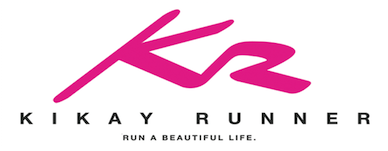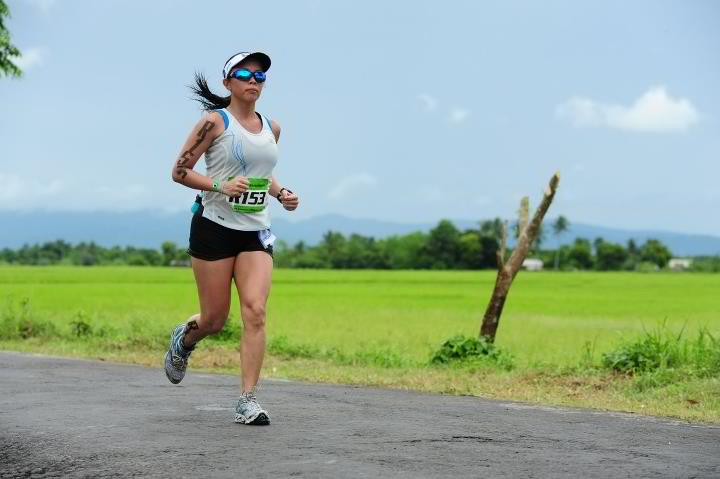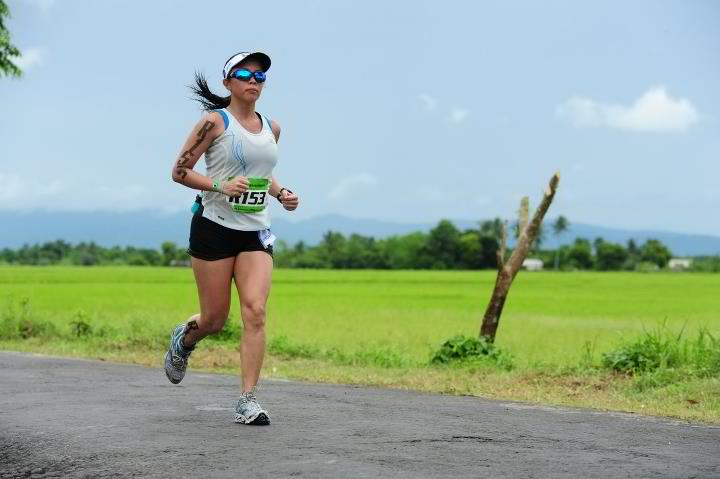This is a new section on my blog where I answer questions people ask me. If you have any questions for future Ask Kikay Runner entries, contact me!
Every few months someone drops me a message in my Facebook profile asking how I train. Presumably it’s so they can do likewise and maybe get the same results or improvements I’ve experienced as a runner. I usually respond with some generic information about the kind of mileage I have when I’m not building mileage and intensity for a 42K.
photo from Ironman Phil
I undertake a lot of training by myself (the so-called “secret training”) because I have unusual liberty with my time, being a TV host and group fitness instructor. Also, believe it or not, most of my hours of training don’t occur on the road or the track! So I don’t think I’m the typical runner who uses running as her main means of keeping fit.
In any case, this is the secret behind the cardio fitness, body awareness, flexibility, and core strength I use for running. I get them from teaching two group fitness programs, BODYJAM and BODYBALANCE.
BODYJAM
[youtube=http://www.youtube.com/watch?v=HQsd-J9hf_w&w=500&h=300]
BODYJAM™ is the cardio workout where you are free to enjoy the sensation of dance. An addictive fusion of the latest dance styles and hottest new sounds puts the emphasis as much on having fun as on breaking a sweat. Funky instructors teach you to move with attitude through this 55-minute class. So grab a friend, get front and center, and get high on the feeling of dance. — Les Mills BODYJAM™
I started taking BODYJAM classes in 2006 and totally loved the combination of creative dance moves that let me express myself, and the interval intensity that raised my cardio fitness level to the point where I could do one-and-a-half hours of the class nonstop (we called these “BODYJAM marathons” at the gym). So when I did my first race (a 10K) in 2009, my legs and my lungs were well-prepared to handle an hour of running.
What makes BODYJAM so great for my cardio fitness is the way a class is structured. We have two intensity peaks within that 55-minute class, with a recovery between them. So it’s like heart rate training because both the aerobic and anaerobic zones are explored during the class.
Additionally, BODYJAM doesn’t just involve the legs; it uses the whole body, so you develop a sense of where your body is in space (“body awareness”). When applied to running, this makes me more aware of how I’m striding and landing, and I can pull up my posture or land more lightly on my feet accordingly. My core is also engaged all throughout to keep my spine stable especially through twists and jumps. Good core strength is vital in keeping good form in running, reducing fatigue (since bad form uses more energy).
Now that I’m an instructor, I teach approximately three hours of BODYJAM in a week; I have two classes on Mondays and one on Tuesdays. Keep in mind that a person needs about 30 minutes, three days a week of moderately-intense exercise to keep the heart healthy.
BODYBALANCE/BODYFLOW
[youtube=http://www.youtube.com/watch?v=xIUwVQjM4PQ&w=500&h=300]
BODYFLOW is the Yoga, Tai Chi, Pilates workout that builds flexibility and strength and leaves you feeling centered and calm. Controlled breathing, concentration and a carefully structured series of stretches, moves and poses to music create a holistic workout that brings the body into a state of harmony and balance. (For copyright reasons, BODYBALANCE™ is known as BODYFLOW™ in the USA). — Les Mills BODYFLOW/BODYBALANCE
I started teaching BODYBALANCE in 2007. The video above is deceptive because it shows only the slow movements we use in the tai chi warm-ups and the slow transitions we have in the yoga poses and Pilates core work. That slowness belies the muscular strength and flexibility these exercises have given me.
A BODYBALANCE class is structured with a Tai Chi-based track plus Sun Salutations to warm-up the body. Yoga-based standing poses develop leg strength and the sense of balance. After some stretches through the hips, Pilates-based mat exercises work the core (both abs and back). Twists and stretches conclude the main work in the class. A focus on using the inhale and exhale with the moves and poses develops lung capacity and the ability to relax under pressure.
Just like BODYJAM, I teach BODYBALANCE three times a week. Applied to running, BODYBALANCE helps me to stay relaxed throughout my stride so I use up less energy. I’ve learned to breathe deeper so I provide more oxygen for my muscles, enabling me to stay longer in the aerobic zone even when increasing speed. The stretches I do in class maintain my range of movement and help my muscles recover. And again, maintaining proper torso form relies on core strength.
I also like trying out different exercises and fitness classes, as well as putting in some time in the pool and on the bike. But these two group fitness classes are the mainstay of my weekly regimen.
So where does running fit into the plan? I do my twice-weekly training runs specifically to get my running muscles used to the motion, check on form, and indulge in some liberating sprint work. Most importantly, I do it for fun!
I think training plans are very personal, and what works for one person might not for another. Do check out the January issue of Runner’s World Philippines (coming out on the 19th!) for some great basic plans on how to start running, then create your own customized training plan from there.



hi ms. noelle, i’m a newbie in running, can you share about stretching exercises before running? and for how long? thank you very much
Hi Mae, I don’t believe in stretching before runs. Rather, I do a dynamic warm-up. Check out my link for some sample movements you can incorporate into a dynamic warm-up. Save the static stretches for after the race. 🙂
Hi Noelle, how do you reduce the instance of cramps happening? I always get cramps when I do 10k runs, always hitting me when I am at the 9th km. What are the preps I can do to prevent (or lessen) it? Thanks.
Aries, try increasing the distance of your longest run in a week gradually (10% weekly) until you can run longer than 10K comfortably. This increases your running fitness and toughens your body beyond the demands of your 10K race.
You may also be pushing too hard at the start of your race, leaving nothing left in the tank by the 9th kilometer.
Hi Ms. Noelle ive been running for more than a year now. I’ve joined a lot of races and always wanted to find out if their is a proper breathing technique when running. Sometimes i think im working out my lungs too much.
Hi! I remember answering this for you on Xpert.PH:
Here are two tips to help you breathe better on your next run:
1. Breathe fully. Singers and yoga and Pilates practitioners learn the difference between “chest breathing”, where only the top of your chest expands when you inhale, and “abdominal breathing”, where even your belly expands as you inhale. Our lungs can expand a lot, stretching from just underneath the collarbone to the belly area under your ribcage. Breathing into only the top part of your lungs (chest breathing) uses only a small part of your lung capacity, so it’s not efficient. In fact, chest breathing causes that feeling of being breathless; it also involuntarily tenses your shoulder and chest muscles, wasting energy. Abdominal breathing lets you breathe more with less effort, flooding your body with the oxygen it needs.
Abdominal breathing takes practice. Place one hand on your chest and the other hand on your belly (just above the bellybutton). As you breathe, the hand on your chest should remain steady while the hand on your belly should move with the expansion and deflation in your abdomen. This kind of breathing also allows you to breathe more slowly, so you don’t hyperventilate and your body gets its cue to relax.
2. Breathe rhythmically. I heard Coach Jojo Macalintal give this advice to Piolo Pascual as we ran the Sunpiology Run 12K last year. He said, “1, 2, 3, breathe, 1, 2, 3, breathe.” He meant for Piolo to inhale for four steps and exhale for four steps. At a sprint pace you might need to breathe in for two steps and breath out for two steps. You can also try a 3-3 pattern, breathing in for three steps then breathing out for three steps.
Again, these breaths need to be deep. If you’re chest breathing, your legs are probably going too fast for your lungs to catch up. You’ll need to slow down to avoid burning yourself out.